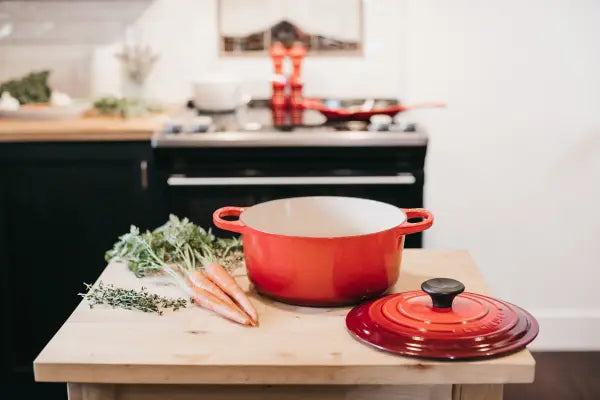What Your Infant Learns Through Self-Feeding—Beyond Just Eating

Self-feeding is a fun, albeit messy, milestone to look forward to for your little one! I loved watching my son’s chubby little fingers grip around food as he excitedly attempted to bring it to his mouth—sometimes missing and sometimes squishing the food into a big blob before it even got to his lips.
While it may seem like just another phase in a baby’s development, it’s much more than that. Self-feeding is a key driver of growth across three big areas:
-
Hand-eye coordination
-
Fine motor development
-
Early cognitive and problem-solving skills
These important skills will also help build your little one’s confidence and independence, as well as give them lots of opportunities to explore the sensory aspects of food (make sure you caught that fun blog post here).
Let’s explore how the process of self-feeding relies on skills across multiple developmental areas and strengthens these foundational abilities—all while fostering a love for exploring different foods.

How does self-feeding help develop hand-eye coordination?
Visual and motor skills begin at the high chair
Hand-eye coordination is the ability to connect what the eyes see with how the hands move. For adults, this happens almost automatically—but for babies, it takes time, repetition, and plenty of practice.
When your infant:
-
Reaches for a spoon
-
Aims it at their mouth
-
Grabs banana slices from their tray
…they’re building a foundational brain-body connection.
What hand-eye coordination looks like in action
At first, these motions are wobbly and messy—spoons will miss, yogurt will fly, and laps will be covered. But over time, the brain starts to make the connection. However, with repetition, your little one’s brain will help refine and improve the process (but full disclosure – I still clean off my fair share of yogurt off my toddler’s lap some days!).
Through trial and error, a child learns how far to extend their arm, how tightly to grip, and how to aim towards their mouth. Although these may seem like small changes and movements, they are significant cognitive milestones that show the brain is learning spatial awareness and body awareness.
Compare it to your little one taking their first wobbly, uneasy steps vs running confidently months later!
Fine motor skills: how self-feeding helps those little hands get stronger
Why finger foods are a workout for small muscles
Dexterity refers to the skillful use of hands and fingers, especially in small, precise movements. While gross motor skills (like crawling and walking) involve large muscle groups, fine motor skills are all about control and finesse – and self-feeding at mealtimes is full of opportunities for babies to build them!
Gripping foods, pinching small pieces between fingers, holding cups, and holding a spoon all require the use of small muscle groups in the hands, fingers, and wrists. The more practice a child has doing these tasks independently, the stronger and more coordinated the muscles and movements become.
Textured foods teach grip and control
Different food types offer different challenges—and that’s a good thing. Slippery avocado, squishy berries, or crunchy crackers each require a unique grip and level of pressure. Over time, your baby learns how to adjust their movements for better control. And mastering fine motor dexterity early on supports success in skills that are needed later, like holding crayons and buttoning clothes.
Fine motor milestones to watch for
-
Palmer grasp (5–6 months): Baby uses their whole hand to hold food
-
Pincer grasp (8–12 months): Baby uses thumb and index finger for smaller items
These skills eventually support more advanced tasks like buttoning clothes, stacking blocks, or holding a crayon.

Is your baby learning to problem-solve at mealtime? Yes, actually.
While many adults don’t necessarily think of eating as a cognitive challenge, self-feeding as a baby is full of small problems they must solve on their own. Figuring out how to pick up a food with their fingers or how to use a spoon effectively is full of them experimenting with how to do something correctly.
What problem-solving looks like at mealtime
Babies must adapt their strategies, just as noted above in the skills we already mentioned. Every one of these challenges encourages them to experiment and is an opportunity for problem-solving. Here are some examples of their problem-solving:
-
Testing techniques (“What if I grip it this way?”)
-
Adjusting methods (“That didn't work—I'll try again”)
-
Learning cause and effect (“When I squeeze, it mushes!”)
Every little win—like finally getting that berry to their mouth—is a mini problem-solving victory that builds confidence and brain power. Pretty special when you really think about it, huh?
Problem-solving during mealtime fosters independence and resilience, which will be critical for your little one’s future. Just sit back and watch in awe as your baby finally picks up that smushed berry after multiple attempts!
How to encourage independent eating in a self-feeding infant
Simple ways to support self-feeding at home
Now that we know how powerful a tool self-feeding is, what can we do as parents to support it? Here are my tips:
-
Start once your child shows readiness signs for starting solids (review those readiness signs here!)
-
Introduce baby-led weaning or responsive feeding approaches – whether offering finger foods, preloaded spoons, or purées – let your baby self-feed and lead
-
Accept the mess! Always easier said than done, but try to remind yourself that mess is a part of the process. Every dropped piece of food is a learning experience!
-
We get that parenting is hard though – pick the best days and times that work for you to let your little one really explore and get messy
Making space for exploration (and a little mess)
-
Use appropriate tools. Child-sized utensils that are easy to grip can make self-feeding more successful and less frustrating
-
Model the behavior. Children learn through observation. Sit with your child and eat together when possible, showing them how to use utensils and their hands to handle food
-
Offer variety. Different textures, shapes, and sizes of food encourage different hand movements and strategies. A squishy avocado offers a different challenge than a crunchy teething cracker
Don’t forget the added benefit: variety also invites more sensory exploration of textures, tastes, and smells!

What your baby gains from self-feeding—beyond nutrition
Wow! Self-feeding is far more than just a messy rite of passage. It is a critical exercise in your baby’s physical and cognitive development. Big kudos to you for giving them this opportunity!
Through self-feeding, little ones:
-
Build hand-eye coordination
-
Strengthen fine motor skills
-
Flex their budding problem-solving muscles
-
Explore sensory details like texture and resistance
-
Gain independence and self-confidence at the table
Each messy bite is a step toward self-reliance, joyful eating, and lifelong learning.
And remember, supporting your baby’s development doesn’t mean you need to embrace chaos at every meal. You don’t have to let them self-feed all the time to make an impact. At Bébé Foodie, we’re all about balance, flexibility, and making it work for you.

Written by Lauren Remondino, MS, CCC-SLP, CLC
Feeding Therapist, Speech Language Pathologist, Lactation Counselor & Advisor at Bébé Foodie
Lauren Remondino is a pediatric feeding specialist and mom, with a background in speech-language pathology and lactation counseling. After years working in top children’s hospitals, she now brings her clinical expertise—and real-life parenting perspective—to Bébé Foodie. Lauren works closely on developing our How to Serve guides and feeding support content, helping parents feel confident at every stage of their baby’s food journey. She’s all about keeping things realistic, flexible, and supportive—because feeding isn’t one-size-fits-all, especially when you’re juggling nap schedules and snack requests.




Leave a comment